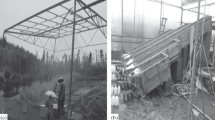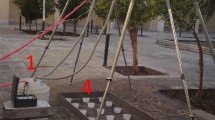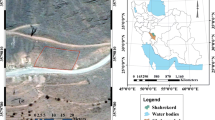Abstract
Soil erosion and the resulting sedimentation constitute major natural hazards that increase land degradation in the Mediterranean region. Understanding the behavior of soil erosion is of particular importance to control the degradation of productive soils. Therefore, a portable field rainfall simulator was designed to provide rainfall intensities in the range of 14 to 80 mm h−1. The simulator was tested in terms of Christiansen uniformity coefficients that ranged from 89 to 94% for the three full-jet nozzles used in this study, with median diameters ranged from 0.836 to 2.113 mm, showing an appropriate degree of accuracy. Furthermore, kinetic energy values ranged from 12.7 to 18.9 J m−2 mm−1, showing similarity to the natural rainfall occurs in the Mediterranean regions under conditions of low rainfall intensity. The applicability of the rainfall simulator in the dynamic processes of erosion characteristics was investigated in the northwestern coastal zone of Egypt. Five rainfall intensities (14, 21, 30, 36, and 45 mm h−1) were evaluated in three repetitions at three uncultivated sites having slope gradients of 5, 9, and 12%, forming 45 simulated rainfalls. The changes of sediment yield and runoff rate for the 45 simulated rainfalls were quantified. Altogether, the results indicated that runoff and sediment yield rates were substantially different between the rainfall intensities of 14 and 45 mm h−1 than those obtained between any other pairs of intensities under all soil gradients. Summing up the findings, the proposed rainfall simulator in this study can be used in future soil erosion studies.







Similar content being viewed by others
References
Abudi I, Carmi G, Berliner P (2012) Rainfall simulator for field runoff studies. J Hydrol 454:76–81
Aksoy H, Unal NE, Cokgor S, Gedikli A, Yoon J, Koca K, Inci SB, Eris E (2012) A rainfall simulator for laboratory-scale assessment of rainfall-runoff-sediment transport processes over a two-dimensional flume. CATENA 98:63–72
Arguelles ACC, Jung M, Pak G, Aksoy H, Kavvas ML, Yoon J (2013) Evaluation of overland flow model for a hillslope using laboratory flume data. Water Sci Technol 68(5):1188–1194
Assouline S, El Idrissi A, Persoons E (1997) Modelling the physical characteristics of simulated rainfall: a comparison with natural rainfall. J Hydrol 196(1–4):336–347
Barthes B, Roose E (2002) Aggregate stability as an indicator of soil susceptibility to runoff and erosion; validation at several levels. CATENA 47(2):133–149
Beard K, Pruppacher HR (1969) A determination of the terminal velocity and drag of small water drops by means of a wind tunnel. J Atmos Sci 26(5):1066–1072
Berger C, Schulze M, Rieke-Zapp D, Schlunegger F (2010) Rill development and soil erosion: a laboratory study of slope and rainfall intensity. Earth Surf Proc Land 35(12):1456–1467
Boulange J, Malhat F, Jaikaew P, Nanko K, Watanabe H (2019) Portable rainfall simulator for plot-scale investigation of rainfall-runoff, and transport of sediment and pollutants. Int J Sedim Res 34(1):38–47
Cerdà A (1997) Rainfall drop size distribution in the Western Mediterranean basin, València Spain. CATENA 30(2–3):169–182
Christiansen JE (1942) Irrigation by sprinkling. University of California, Agricultural Experimental Station, Bull, p 670
Clarke MA, Walsh RP (2007) A portable rainfall simulator for field assessment of splash and slopewash in remote locations. Earth Surf Process Landf J Br Geomorphol Res Group 32(13):2052–2069
Conway LS, Yost MA, Kitchen NR, Sudduth KA, Veum KS (2018) Cropping system, landscape position, and topsoil depth affect soil fertility and nutrient buffering. Soil Sci Soc Am J 82(2):382–391
Covert A, Jordan P (2009) A portable rainfall simulator: techniques for understanding the effects of rainfall on soil erodibility. Streamline Watershed Manag Bull 13(1):5–9
De Lima JL, Tavares P, Singh VP, de Lima MI (2009) Investigating the nonlinear response of soil loss to storm direction using a circular soil flume. Geoderma 152(1–2):9–15
Defersha MB, Melesse AM (2012) Effect of rainfall intensity, slope and antecedent moisture content on sediment concentration and sediment enrichment ratio. CATENA 90:47–52
Deng L, Sun T, Fei K, Zhang L, Fan X, Wu Y, Ni L (2020) Effects of erosion degree, rainfall intensity and slope gradient on runoff and sediment yield for the bare soils from the weathered granite slopes of SE China. Geomorphology 352:106997
Dlamini P, Orchard C, Jewitt G, Lorentz S, Titshall L, Chaplot V (2011) Controlling factors of sheet erosion under degraded grasslands in the sloping lands of KwaZulu-Natal, South Africa. Agric Water Manag 98(11):1711–1718
Esteves M, Planchon O, Lapetite JM, Silvera N, Cadet P (2000) The ‘EMIRE’large rainfall simulator: design and field testing. Earth Surf Process Landf J Br Geomorphol Res Group 25(7):681–690
Fang H, Sun L, Tang Z (2015) Effects of rainfall and slope on runoff, soil erosion and rill development: an experimental study using two loess soils. Hydrol Process 29(11):2649–2658
Grismer M (2012) Standards vary in studies using rainfall simulators to evaluate erosion. Calif Agric 66(3):102–107
Grismer ME (2016) Determination of watershed infiltration and erosion parameters from field rainfall simulation analyses. Hydrology 3(3):23
Hassel J, Richter G (1988) Die Niederschlagsstruktur des Trierer Regensimulators. Mitteilungen der Deutschen Bodenkundlichen Gesellschaft 56:93–96
Iserloh T, Fister W, Seeger M, Willger H, Ries JB (2012) A small portable rainfall simulator for reproducible experiments on soil erosion. Soil Tillage Res 124:131–137
Iserloh T, Ries JB, Cerdà A, Echeverría MT, Fister W, Geißler C, Kuhn NJ, León FJ, Peters P, Schindewolf M, Schmidt J (2013) Comparative measurements with seven rainfall simulators on uniform bare fallow land. Zeitschrift für Geomorphologie 57(1):11–26
Jiang FS, Huang YH, Wang MK, Lin JS, Zhao G, Ge HL (2014) Effects of rainfall intensity and slope gradient on steep colluvial deposit erosion in southeast China. Soil Sci Soc Am J 78(5):1741–1752
Kavian A, Mohammadi M, Cerda A, Fallah M, Abdollahi Z (2018) Simulated raindrop's characteristic measurements. A new approach of image processing tested under laboratory rainfall simulation. Catena 167:190–197
Keesstra S, Mol G, De Leeuw J, Okx J, De Cleen M, Visser S (2018) Soil-related sustainable development goals: four concepts to make land degradation neutrality and restoration work. Land 7(4):133
Kesgin E, Dogan A, Agaccioglu H (2018) Rainfall simulator for investigating sports field drainage processes. Measurement 125:360–370
Kisić I, Bogunović I, Zgorelec Ž, Bilandžija D (2018) Effects of soil erosion by water under different tillage treatments on distribution of soil chemical parameters. Soil Water Res 13(1):36
Krajewski WF, Kruger A, Caracciolo C, Golé P, Barthes L, Creutin JD, Delahaye JY, Nikolopoulos EI, Ogden F, Vinson JP (2006) DEVEX-disdrometer evaluation experiment: basic results and implications for hydrologic studies. Adv Water Resour 29(2):311–325
Lassu T, Seeger M, Peters P, Keesstra SD (2015) The Wageningen rainfall simulator: set-up and calibration of an indoor nozzle-type rainfall simulator for soil erosion studies. Land Degrad Dev 26(6):604–612
Liu D, She D, Shao G, Chen D (2015) Rainfall intensity and slope gradient effects on sediment losses and splash from a saline–sodic soil under coastal reclamation. CATENA 128:54–62
Lora M, Camporese M, Salandin P (2016) Design and performance of a nozzle-type rainfall simulator for landslide triggering experiments. CATENA 140:77–89
Miller WP (1987) A solenoid-operated, variable intensity rainfall simulator. Soil Sci Soc Am J 51(3):832–834
Moazed H, Bavi A, Boroomand-Nasab S, Naseri A, Albaji M (2010) Effects of climatic and hydraulic parameters on water uniformity coefficient in solid set systems. J Appl Sci (Faisalabad) 10(16):1792–1796
Mohamed E, Schutt B, Belal A (2013) Assessment of environ-mental hazards in the northwestern coast-Egypt using RS and GIS. Egypt J Remote Sens Space Sci 16:219–229
Morin J, Goldberg D, Seginer I (1967) A rainfall simulator with a rotating disk. Trans ASAE 10(1):74–0077
Pena SB, Abreu MM, Magalhães MR, Cortez N (2020) Water erosion aspects of land degradation neutrality to landscape planning tools at national scale. Geoderma 363:114093
Pérez-Latorre FJ, de Castro L, Delgado A (2010) A comparison of two variable intensity rainfall simulators for runoff studies. Soil Tillage Res 107(1):11–16
Qian F, Cheng D, Ding W, Huang J, Liu J (2016) Hydraulic characteristics and sediment generation on slope erosion in the Three Gorges Reservoir Area. China J Hydrol Hydromech 64(3):237–245
Ramos MC, Martínez-Casasnovas JA (2006) Nutrient losses by runoff in vineyards of the Mediterranean Alt Penedès region (NE Spain). Agr Ecosyst Environ 113(1–4):356–363
Ribolzi O, Patin J, Bresson LM, Latsachack KO, Mouche E, Sengtaheuanghoung O, Silvera N, Thiébaux JP, Valentin C (2011) Impact of slope gradient on soil surface features and infiltration on steep slopes in northern Laos. Geomorphology 127(1–2):53–63
Ries JB, Seeger M, Iserloh T, Wistorf S, Fister W (2009) Calibration of simulated rainfall characteristics for the study of soil erosion on agricultural land. Soil Tillage Res 106(1):109–116
Rodríguez-Blanco ML, Arias R, Taboada-Castro MM, Nunes JP, Keizer JJ, Taboada-Castro MT (2016) Sediment yield at catchment scale using the SWAT (soil and water assessment tool) model. Soil Sci 181(7):326–334
Salem HM, Meselhy A, Elhagarey M, Ali AM, Wu W (2020) Soil erosion control and wheat productivity are improved by a developed ridge-furrow and reservoir tillage systems. Arch Agron Soil Sci 1–10
Salem HM, Valero C, Muñoz MÁ, Gil-Rodríguez M (2015) Effect of integrated reservoir tillage for in-situ rainwater harvesting and other tillage practices on soil physical properties. Soil Tillage Res 151:50–60
Salem HM, Valero C, Muñoz MÁ, Gil-Rodríguez M, Barreiro P (2014) Effect of reservoir tillage on rainwater harvesting and soil erosion control under a developed rainfall simulator. CATENA 113:353–362
Salles C, Poesen J, Borselli L (1999) Measurement of simulated drop size distribution with an optical spectro pluviometer: sample size considerations. Earth Surf Process Landf J Br Geomorphol Res Group 24(6):545–556
Shen H, Zheng F, Wen L, Han Y, Hu W (2016) Impacts of rainfall intensity and slope gradient on rill erosion processes at loessial hillslope. Soil Tillage Res 155:429–436
Shi ZH, Yan FL, Li L, Li ZX, Cai CF (2010) Interrill erosion from disturbed and undisturbed samples in relation to topsoil aggregate stability in red soils from subtropical China. CATENA 81(3):240–248
Tossell RW, Dickinson WT, Rudra RP, Wall GJ (1987) A portable rainfall simulator. Can Agric Eng 29(2):155–162
Uijlenhoet R, Stricker JNM (1999) A consistent rainfall parameterization based on the exponential raindrop size distribution. J Hydrol 218(3–4):101–127
UNCCD (2016) Convention to combat desertification report of the conference of the parties on its twelfth session. Conf Parties 20831:1–80
Vahabi J, Nikkami D (2008) Assessing dominant factors affecting soil erosion using a portable rainfall simulator. Int J Sedim Res 23(4):376–386
Van Dijk AI, Bruijnzeel LA, Rosewell CJ (2002) Rainfall intensity–kinetic energy relationships: a critical literature appraisal. J Hydrol 261(1–4):1–23
Visser S, Keesstra S, Maas G, De Cleen M (2019) Soil as a basis to create enabling conditions for transitions towards sustainable land management as a key to achieve the SDGs by 2030. Sustainability 11(23):6792
Wang N, Jiao JY, Lei D, Chen Y, Wang DL (2014) Effect of rainfall erosion: seedling damage and establishment problems. Land Degrad Dev 25(6):565–572
Wang Z, Yang X, Liu J, Yuan Y (2015) Sediment transport capacity and its response to hydraulic parameters in experimental rill flow on steep slope. J Soil Water Conserv 70(1):36–44
Wu X, Wei Y, Wang J, Xia J, Cai C, Wu L, Fu Z, Wei Z (2017) Effects of erosion degree and rainfall intensity on erosion processes for Ultisols derived from quaternary red clay. Agr Ecosyst Environ 249:226–236
Zhao L, Hou R, Wu F, Keesstra S (2018) Effect of soil surface roughness on infiltration water, ponding and runoff on tilled soils under rainfall simulation experiments. Soil Tillage Res 179:47–53
Zhao X, Wu P, Chen X, Helmers MJ, Zhou X (2013) Runoff and sediment yield under simulated rainfall on hillslopes in the Loess Plateau of China. Soil Res 51(1):50–58
Ziadat FM, Taimeh AY (2013) Effect of rainfall intensity, slope, land use and antecedent soil moisture on soil erosion in an arid environment. Land Degrad Dev 24(6):582–590
Acknowledgement
This study was funded by the Desert Research Center, Egypt, as well as by the East China University of Technology, Nanchang China through the Research Startup Funding, Grant No. (110/1410000475).
Author information
Authors and Affiliations
Corresponding author
Ethics declarations
Conflict of interest
The authors declare that they have no conflict of interest.
Additional information
Publisher's Note
Springer Nature remains neutral with regard to jurisdictional claims in published maps and institutional affiliations.
Rights and permissions
About this article
Cite this article
Salem, H.M., Meselhy, A.A. A portable rainfall simulator to evaluate the factors affecting soil erosion in the northwestern coastal zone of Egypt. Nat Hazards 105, 2937–2955 (2021). https://doi.org/10.1007/s11069-020-04432-8
Received:
Accepted:
Published:
Issue Date:
DOI: https://doi.org/10.1007/s11069-020-04432-8




